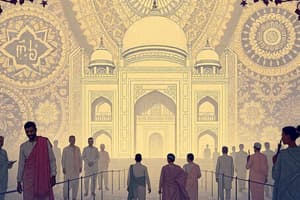Podcast
Questions and Answers
গান্ধীর কি ভূমিকা ছিল সোনার যুগের অবসানে?
গান্ধীর কি ভূমিকা ছিল সোনার যুগের অবসানে?
- সোনার যুগের ক্ষুদ্র অংশ
- সোনার যুগের অন্যতম নেতা (correct)
- সোনার যুগের ফিক্ষ্ডাঃ
- সোনার যুগের প্রধান নেতা
1930 সালে শুরু হয়েছিল কোন ঘটনা?
1930 সালে শুরু হয়েছিল কোন ঘটনা?
- নাকি ভারতীয় উপনিবেশ (correct)
- সাধারণ উপনিবেশ
- অনুশাসন
- অনুপালন
ভারতের বিভাজনের কারণ ছিল:
ভারতের বিভাজনের কারণ ছিল:
- রাজনৈতিক অনৌপাতিক
- রাষ্ট্রিয় ধার্মিক ভিত্তি (correct)
- আর্থিক তর্ক
- সামাজিক বিভাজন
নারীরা 1947-1948-র মধ্যে, Role of Women in the Independence Movement-ের অংশ:
নারীরা 1947-1948-র মধ্যে, Role of Women in the Independence Movement-ের অংশ:
Partition of India-র massive displacement and ethnic conflict-er 결과_:
Partition of India-র massive displacement and ethnic conflict-er 결과_:
গান্ধীর দরবেশিতা কি ছিল?
গান্ধীর দরবেশিতা কি ছিল?
১৯১৯ এর রোলেট আইনের প্রতিক্রিয়ার মাধ্যমে গান্ধী কি আন্দোলন চালিয়েছিলেন?
১৯১৯ এর রোলেট আইনের প্রতিক্রিয়ার মাধ্যমে গান্ধী কি আন্দোলন চালিয়েছিলেন?
১৯২০ সালে, লাহোরে, ৪১ জনের মৃত্যুর ফলে, কি ঘটে?
১৯২০ সালে, লাহোরে, ৪১ জনের মৃত্যুর ফলে, কি ঘটে?
Flashcards are hidden until you start studying
Study Notes
Indian National Movement
The Indian national movement was a series of political campaigns initiated by the Indians during British rule to attain self-governance. This period marked significant milestones in the history of India, with several notable leaders and movements shaping its course towards independence.
Gandhi's Leadership
Mohandas Karamchand Gandhi, known as Mahatma Gandhi, emerged as one of the most influential figures leading the Indian national movement. Born in Gujarat, India, he spent his early years studying law in London before returning to South Africa, where he faced racial discrimination and became involved in activism. These experiences shaped his philosophy of nonviolence, which he later applied to India's struggle against British rule.
Gandhi advocated for civil disobedience and passive resistance. He believed that peaceful protest could bring about change without resorting to violence. His leadership inspired many Indians to join in the fight for independence, and his methods influenced social justice movements worldwide.
Non-Cooperation Movement
In response to Rowlatt Acts of 1919, which were designed to curtail civil liberties, Gandhi launched the Non-Cooperation Movement. This campaign encouraged Indians to withdraw their cooperation from British institutions, including schools, courts, and government offices. However, it quickly escalated into violent protests when police fired upon demonstrators at Lahore in February 1920, resulting in 41 deaths. Despite the bloodshed, the movement helped raise awareness about the harsh realities of colonial rule and contributed to the growing dissent against the British Raj.
Civil Disobedience Movement
Another pivotal moment came with the Civil Disobedience Movement, which began in 1930. Inspired by the Salt Satyagraha, thousands of Indians marched to break the salt laws, refusing to pay taxes on imported salt or produce homemade salt. Jailed for his role in this event, Gandhi continued to lead the movement even after being released in 1931.
Despite facing opposition, the Civil Disobedience Movement gained widespread support among urban and rural populations alike, further weakening the foundations of British authority.
Partition of India
After decades of intense negotiations between Congress and Muslim League, Britain decided to withdraw from power through a process called the partition of India, dividing it into two separate states – India and Pakistan. This division was based on religious lines, with predominantly Hindu India and predominantly Muslim Pakistan. Massive displacement and ethnic conflict followed, affecting millions of people.
Role of Women in the Independence Movement
Women played crucial roles in the Indian independence movement. Activists like Matangini Hazra led peasant uprisings while others participated in protests alongside men. In some cases, they served as spies, delivering messages or providing intelligence to freedom fighters during times of unrest. Their courageous acts challenged societal norms and broadened perspectives around gender roles within the nationalist discourse.
These events showcase how various elements, such as leadership, grassroots mobilization, and strategic political maneuvers, collectively led to India's independence from British rule.
Studying That Suits You
Use AI to generate personalized quizzes and flashcards to suit your learning preferences.




